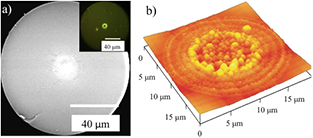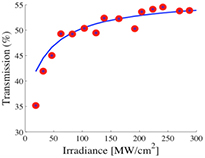Abstract
In this work, a passively Q-switched erbium-doped ring laser using zinc nanoparticles as a saturable absorber is studied and experimentally demonstrated. To achieve this, a saturable absorber was developed through a selective incorporation of zinc nanoparticles onto the core of an optical fiber using a coherent light source of an infrared laser at 1550 nm, then the saturable absorber was inserted into a laser cavity. The laser has a threshold pump power of 57.7 mW at 980 nm, and a range of pulse-repetition rate from 12.3 to 43 kHz. The highest pulse energy of 2.6 nJ was obtained at a repetition rate of 43 kHz and an output wavelength of 1565.5 nm. In addition, the saturable absorber was morphologically characterized by using both scanning electron and atomic force microscopy showing a uniform distribution of nanoparticles deposited on the optical fiber core. This is, to the best of our knowledge, the first demonstration of a Q-switched fiber laser using Zn nanoparticles as a device of saturable absorption.
Export citation and abstract BibTeX RIS

Original content from this work may be used under the terms of the Creative Commons Attribution 3.0 licence. Any further distribution of this work must maintain attribution to the author(s) and the title of the work, journal citation and DOI.
1. Introduction
Recently, there has been a growing interest in the study of new saturable absorbers (SAs) to be employed in pulsed lasers operating in the 1500 nm band; particularly the Q-switched erbium-doped fiber lasers (EDFLs) which are widely used in applications in the field of optical sensing, reflectometry, medicine, laser processing, telecommunications [1–3], and so on. Compared to actively Q-switched fiber lasers, passively Q-switched possess the advantages of simplicity, compactness, and flexibility in design. Passively Q-switched fiber lasers have been investigated using different kinds of SAs such as transition metal doped crystals [4–7], semiconductor saturable absorber mirrors (SESAMs) [8, 9], nonlinear polarization rotation [10, 11], and recently single-wall carbon nanotubes (SWNTs) [12–14]. Although the SWNTs require complex fabrication and expensive packing, they are often demanded for obtaining a broad wavelength range of saturable absorption [15].
Studies of nonlinear optical properties of zinc nanoparticles (ZnNPs), especially of the third-order susceptibility, have revealed a typical nonlinear behavior of a SA [16]. These properties based on the surface plasmon phenomenon, offer a great potential for the fabrication of optoelectronic devices that make them very attractive for the development of optical applications [16, 17].
In this work, a passively Q-switched EDFL using ZnNPs as a SA was experimentally demonstrated and studied in detail. For this study, the SA was constructed using the photodeposition technique previously reported in [16]. The laser with ZnNPs as a SA can produce highly stable microsecond pulses in a broad range of pump power. The SA is easy to implement and inexpensive compared to other techniques.
2. Experimental details
In order to make the SA, a homogeneous solution was prepared by mixing approximately 10 mg of ZnNPs with 10 ml of isopropyl alcohol and then it was ultrasonicated for 20 min to disintegrate nanospheres bundles. This procedure was previously reported in [18]. To deposit the ZnNPs onto the core of an optical fiber, an infrared laser diode (LD) with a wavelength of 1550 nm and variable optical power was used. The optical fiber preparation consisted of removing the plastic cover with a fiber stripping, once the coating is uncovered it was necessary to do a cross-section cut with a fiber cleaver to have a uniform section of the core. After that, the optical power out of the connector was measured using an optical power meter. Then, the fiber was dipped into the nanoparticles solution at room temperature. With this technique, the optical power can be monitored during the deposition process in order to have control over the quantity of nanostructures deposited onto the core of the optical fiber and thus optimize the SA.
Figure 1 shows images obtained with a scanning electron microscope (SEM) and an atomic force microscope (AFM) of the transverse surface of the core of an optical fiber after ZnNPs were deposited. Figure 1(a) shows the result when 50 mW of radiation was propagated in the fiber and it was dipped in the solution for 5 min. It was possible to observe that the ZnNPs were deposited on the fiber core through radiation. Figure 1(b) shows the morphology of the ZnNPs deposited on the fiber core obtained by an AFM in contact mode. This figure shows the surface roughness through formation of concentric ring structures attributed to the distribution of different sizes of nanoparticles mixed in the solution. The height of the surface roughness obtained near the core was estimated by measurements ranging from 40 to 50 nm. This technique of photodeposition of metallic nanoparticles through an infrared source makes it advantageous in comparison with other techniques because it can be used in a wide range of wavelengths, besides it is possible to carry out the photodeposition massive and selective of metallic nanoparticles onto the core of an optical fiber.
Figure 1. (a) SEM image of the fiber end dipped into the solution for 5 min and image obtained from an optical microscope (inset), (b) 3D AFM image of ZnNPs photodeposited onto the core of an optical fiber.
Download figure:
Standard image High-resolution imageThe nonlinear absorption of the sample with ZnNPs was characterized by the P-scan technique using a high gain pulsed erbium-doped fiber amplifier [19]. The dependence of the nonlinear transmission is shown in figure 2. The curve shows normalized transmittance, indicating the presence of nonlinear absorption saturation. The filled red circles indicate the measured data, where each point corresponding to the average value of 50 data and the solid line represents the theoretical fit. The calculated nonlinear absorption coefficient β was −1.49 × 10−6 (m W−1) and the imaginary part of the third-order nonlinear susceptibility χ(3) was calculated to be −7.47 × 10−7 (esu).
Figure 2. Dependence of transmittance of ZnNPs deposited onto the core of an optical fiber.
Download figure:
Standard image High-resolution imageThe Q-switched EDFL configuration is shown in figure 3. The fiber with ZnNPs deposited onto the core was cut and inserted into the cavity as a SA. The side of the fiber, where the nanoparticles were deposited, was connected to the cavity through a capillary of ~150 µm in diameter (borosilicate glass tube). To align and bring the fibers to the capillary, a microscope was used. The fiber laser was pumped by a 980 nm LD through a wavelength-division multiplexer (WDM). A 12 m long single-mode EDF was used as the gain medium, which will emit around 1550 nm under pump. The SA was coupled to the cavity by an isolator (ISO) to provide unidirectional operation and to avoid backward reflection. The 20% port of an optical coupler was used to extract the output power. The polarization controller (PC) was utilized into the laser cavity to adjust the polarization state of laser in best resonance.
Figure 3. Experimental setup for the passively Q-switched EDFL using ZnNPs as SA.
Download figure:
Standard image High-resolution image3. Results and discussion
The self-starting in the laser cavity was presented at 57.7 mW after optimizing the power in the cavity through a PC. The pulse-repetition rate of the Q-switched EDFL can be widely tuned from 12.3 to 43 kHz by varying the pump power from 57.7 to 168.3 mW. The typical pulse train was measured by a photodetector (PD) with a bandwidth of 2 GHz. At every repetition rate and pump power, the Q-switching pulse output was stable. Figure 4 shows the oscillograms of laser pulses, where it can be seen that the Q-switched pulse train has uniform pulse shapes for different pump powers. Note that the performance of this laser is very good compared to other techniques for SA preparation, including those based on carbon nanotubes [12, 14].
Figure 4. Typical oscilloscope traces of the Q-switched pulse trains under different pump powers: (a) 57.75, (b) 98.7, (c) 130 and (d) 168.3 mW.
Download figure:
Standard image High-resolution imageFigure 5 shows the pulse width, frequency and pulse energy as a function of the pump power. A stable Q-switch mode was observed within the range 57.7–168.3 mW of pump power obtained without extra pumped power. According to figure 5(a), at the pump power of 57.7 mW, the EDFL has a pulse duration of 11 µs and a frequency of 12.3 kHz, then by increasing the pump power the pulse width decreases in an exponential way and the frequency increases linearly. Figure 5(b) shows the pulse energy as a function of the pump power. The maximum pulse energy was measured to be 2.6 nJ at a pump power of 168.3 mW with a frequency of 43 kHz, and the lowest measured pulse energy was 0.2 nJ at pump power 57.7 mW with a frequency of 12.3 kHz. The pump power was limited within this range to avoid optical power inducing thermal damage of the ZnNPs. According to the reported studies in [20–23], where the nanoparticles are used as a saturable absorption device, the repetition rates in optical fiber lasers are less than 100 kHz, and the pulses duration are less than 20 µs. In this paper, the experimental values of the pulses obtained in a Q-switched fiber laser are similar in duration and repetition rate to those reported in this paper.
Figure 5. (a) Frequency and pulse width as a function of the incident pump power and (b) pulse power and pulse energy as a function the incident pump power.
Download figure:
Standard image High-resolution imageBy using an optical spectrum analyzer (OSA) with spectral resolution of 0.03 nm, we measured the typical output optical spectrum at the pump power of 120 mW as shown in figure 6. The laser shows a wavelength oscillation of 1565.5 nm. As a result, it is confirmed that the output results are due to the ZnNPs photodeposited onto the core of the optical fiber.
Figure 6. Laser output spectrum of Q-switch mode.
Download figure:
Standard image High-resolution imageThe experimental results of the laser reported in this paper were verified several times confirming the self-pulsing. A test of the EDFL without SA in the cavity was carried out; in this case, it was not possible to obtain an answer of Q-switching with various pump power levels. As an additional test, the direction of the circulator was inverted in figure 3 to be counterclockwise. This change of resonance direction reduces the relative photon density in the absorptive erbium section, and therefore suppresses the self-pulsing. The results obtained confirmed that in the experimental setup the ZnNPs are working as a SA. Therefore we consider that the most important aspect to highlight in this work is that the ZnNPs are working as a SA in a passively Q-switched EDFL. Finally, this SA made by nanoparticles is low cost and easier to prepare compared to the SWCNTs, which the fabrication procedure are complex, costly, and environment unfriendly [24].
4. Conclusion
A compact Q-switched EDFL has been proposed, and experimentally demonstrated with a SA based on ZnNPs photodeposited onto the core of an optical fiber. The laser has a low pump power threshold of 57.7 mW, a wide range of repetition rate from 12.3 to 43 kHz. The highest pulse energy of 2.6 nJ was obtained at an output of 1565.5 nm. The main distinction of this work is the usefulness of photodeposited metal nanoparticles on an optical fiber as a saturable absorption device in optical fiber lasers. This new class of device offers many advantages, over the traditional SWCNT-based devices, such as low manufacturing cost complexity and loss, environmental robustness. This is, to the best of our knowledge, the first demonstration of Zn-based nanoparticles Q-switched laser.
Acknowledgments
This work was supported by CONACyT through grant No. 130 983, PRODEP-SEP through grant No.511-6/17-8017, and VIEP by the Benemérita Universidad Autónoma de Puebla through grant No. 00205.







